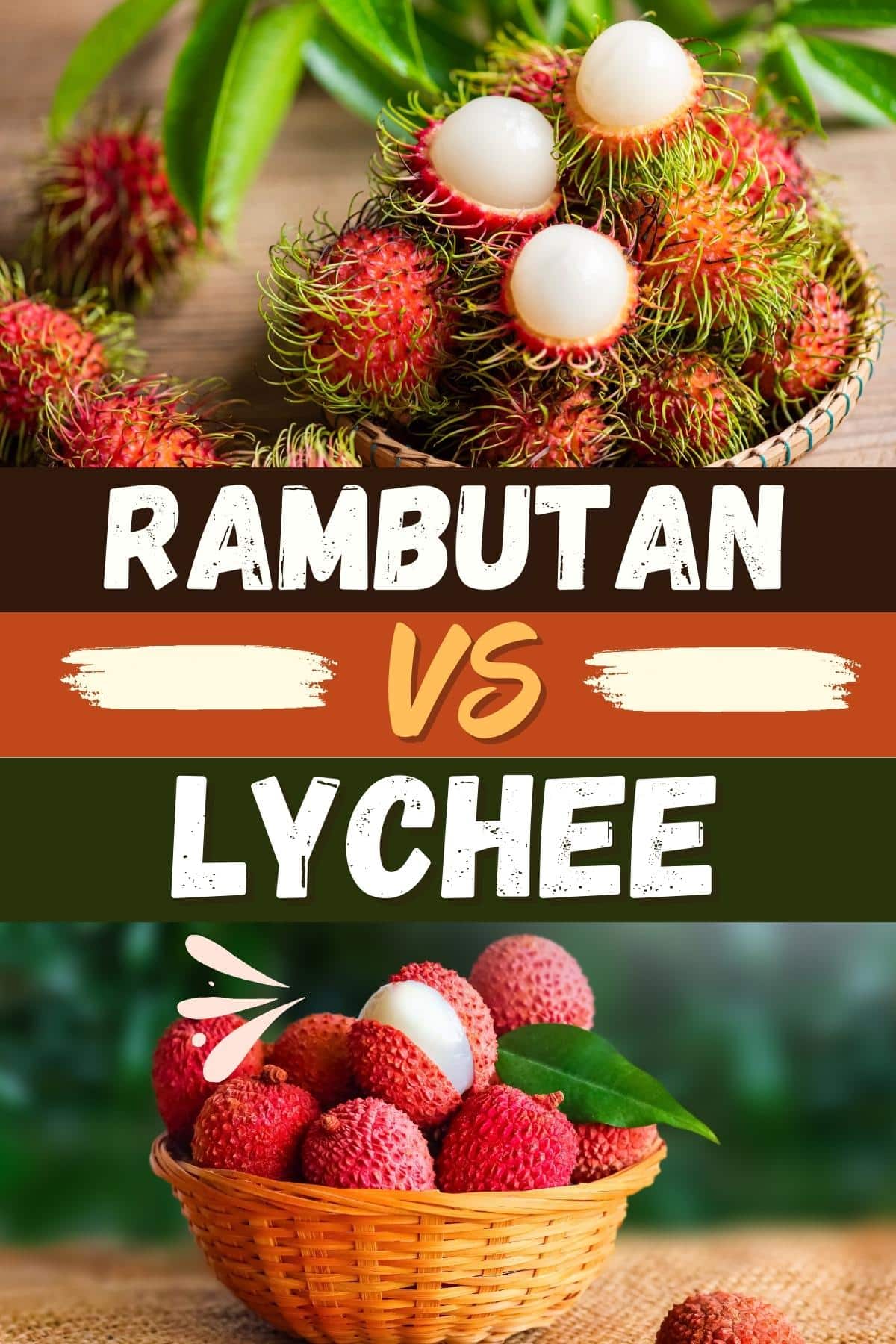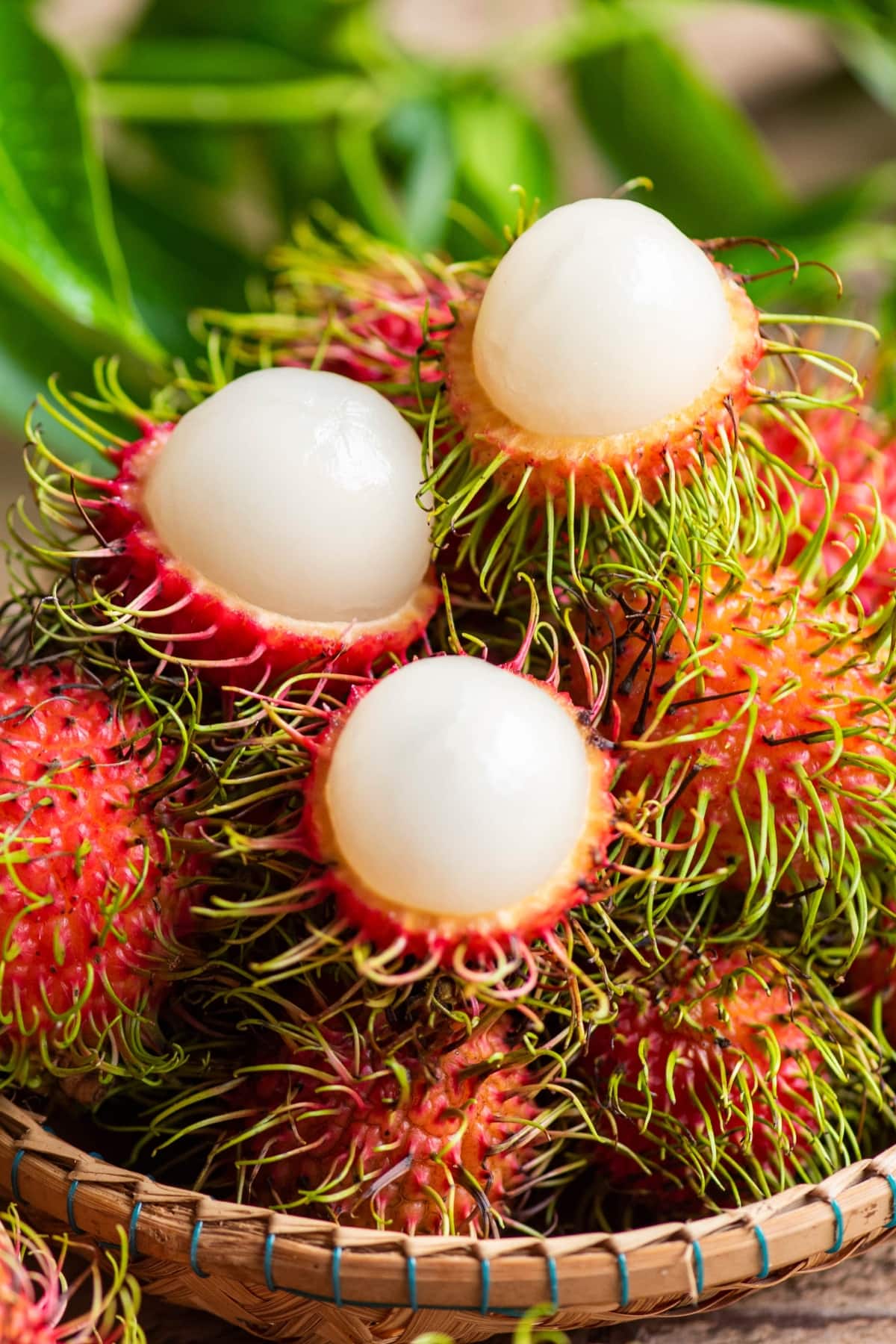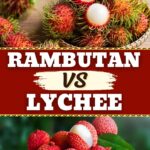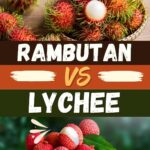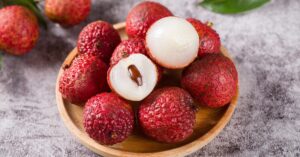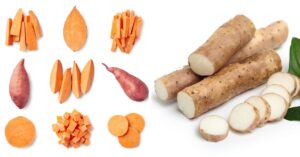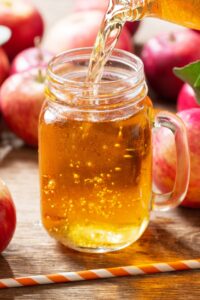Welcome to a showdown of tropical Asian fruits: Rambutan vs. Lychee!
In the red corner: the hairy rambutan with its sweet, tart flavors. And in the pink corner: the lychee, boasting sweet, floral tastes.
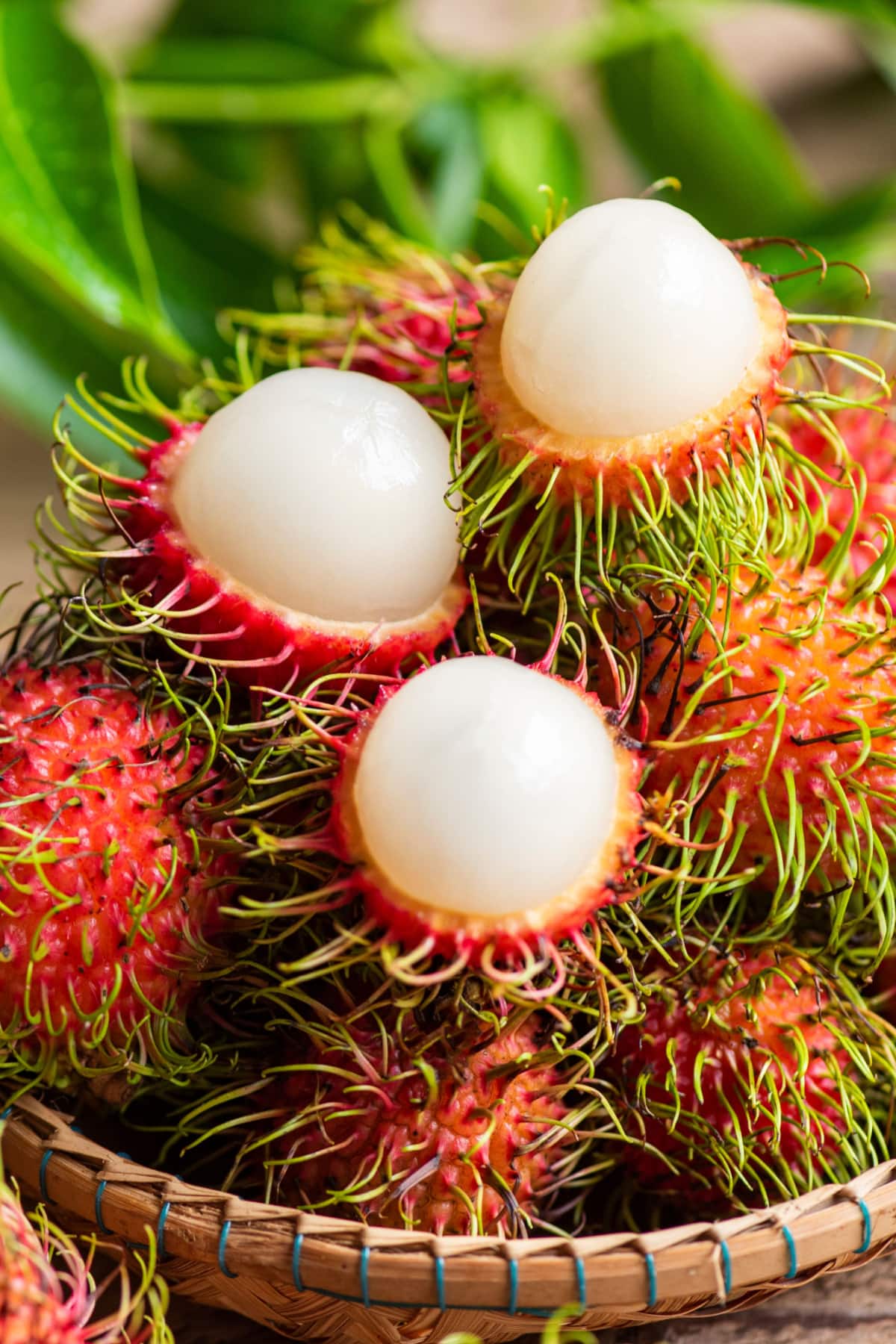
Rambutan and lychee are often mistaken for the other, especially without their skins. Both are reddish-skinned, white-fleshed, juicy, delicious, and exotic.
In this post, we’ll peel back the layers of these tropical gems. Discover their origins, appearance, taste, nutrition, and culinary uses.
Which fruit will claim the crown in the Rambutan vs. Lychee showdown? There’s only one way to find out. Keep reading!
Rambutan vs. Lychee (What’s the Difference?)
Origins
Rambutan: Native to Southeast Asia, specifically the Malay Peninsula. Rambutans need hilly terrains with deep, well-drained soil.
Lychee: Originally from China, specifically the area of Guangdong and Fujian provinces. Lychees prefer summer heat, humidity, rain, and slightly acidic soils.
Appearance
Rambutan: Oval-shaped, about 1-2 inches in diameter. Rambutan is most famous for its vibrant skin (usually red, sometimes yellow) covered with soft, hair-like spines.
Lychee: Slightly smaller than rambutan, about 1 inch in diameter. The outer surface features a rough, leathery red-pink rind.
Taste and Texture
Rambutan: Has a sweet and creamy taste with a slight hint of sourness. People often compare its flavor to grapes.
The texture is jelly-like but slightly firmer than lychee.
Lychee: Also sweet, but it has a more distinct floral taste. It’s often compared to a combination of pear and grape with a hint of rosewater.
Texture-wise, it is jelly soft and juicy.
Nutrition
Rambutan: Low in calories, packed with vitamin C, and rich in fiber.
It has essential vitamins and minerals like folate, vitamin B5, calcium, and phosphorus.
Lychee: Low in calories but big on vitamins, especially Vitamin C. It’s also an excellent source of dietary fiber.
Plus, it contains minerals like magnesium, copper, potassium, and phosphorus.
Culinary Uses
Rambutan: Most people eat this fruit fresh. But it is also fantastic in jams, jellies, and fruit salads.
What makes this fruit stand out is its use in curries or soups to add sweetness.
Lychee: Most people consume fresh lychee. But it comes in various forms- canned, dried, or syrups.
This fruit is a classic ingredient for refreshing treats like lychee cocktails, smoothies, or salads. You can use it in baked goods like cakes and tarts.
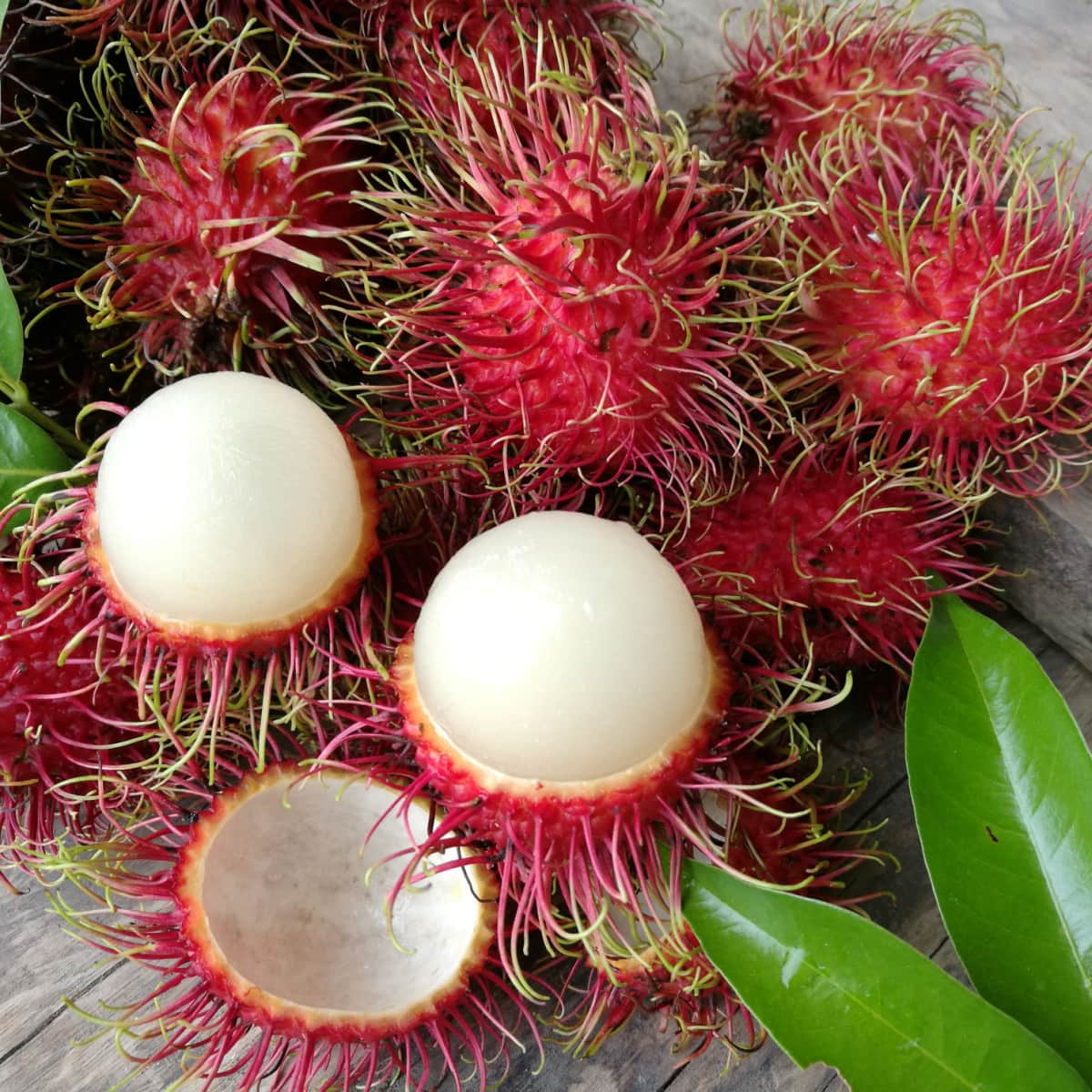
What is Rambutan?
Meet the rambutan, a superstar of the tropical fruit world!
This exotic gem hails from Southeast Asia’s sunny locales like Indonesia, Malaysia, Philippines, and Thailand.
As a proud member of the Sapindaceae family, it shares similar features with lychee and longan.
But what sets the rambutan apart? Its fabulous, funky exterior, of course!
Rambutan is a small, oval fruit coated with hair-like spikes that are usually vibrant red. But sometimes, it is sunny yellow.
In fact, its playful name, “rambut,” literally translates to “hair” in Malay.
Inside, you’ll discover a juicy, translucent-white flesh that tastes sweet with a whisper of tartness. But watch out for the sizable seed at its heart.
How to Peel a Rambutan
Peeling a rambutan can be an adventure with its fun exterior.
Here are the simple steps to unveil its juicy sweetness inside:
- Hold the Fruit: Start by holding the rambutan in one hand with the seam running horizontal.
- Cut the Skin: Using a sharp knife in your other hand, make a shallow cut around the middle of the fruit. Be careful not to cut too deep- you only want to slice the skin.
- Open the Fruit: After you’ve cut around the rambutan, use your fingers to pry open the skin at the cut. The skin should separate easily, revealing the juicy fruit inside.
- Remove the Flesh: Hold the fruit and squeeze gently, and the fleshy part should pop out.
- Dispose of the Seed: The edible part of the rambutan surrounds a large seed in the center. Enjoy the fruit and spit out the seed.
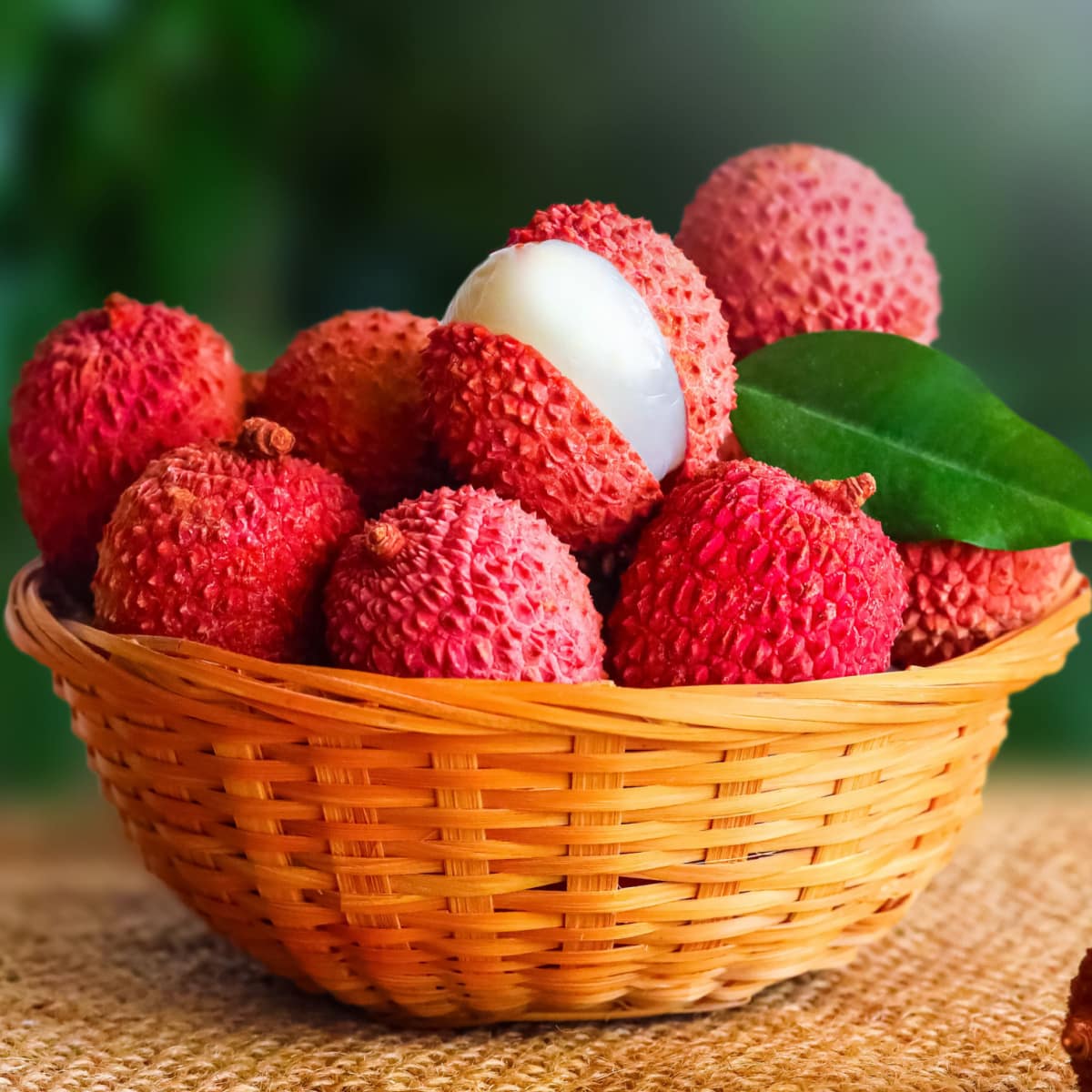
What is Lychee?
With ancient roots in China, lychee has won hearts across the globe. It has a sweet, aromatic taste and unique texture.
Belonging to the Sapindaceae family, lychee shares its lineage with rambutan and longan.
The lychee sure knows how to make an impression! It’s adorned with a bumpy, leathery rind that blushes pink-red when ripe.
Despite its rough exterior, inside, it holds a luscious treasure.
Its translucent-white flesh is delightfully sweet and the texture is juicy yet subtly crisp.
But be careful! Hidden inside this delicious pulp is a large, inedible seed!
How to Peel A Lychee Fruit
Peeling lychee is quite simple, thanks to its thin, leathery skin.
Here’s how to do it:
- Hold and Pierce: Hold the lychee fruit in one hand. Pierce the bumpy outer skin using your fingernail.
- Peel the Skin: Use your fingers to peel off the skin. The skin should come off easily, revealing the translucent, juicy fruit inside.
- Remove the Seed: Bite into the fruit and spit out the seed. You can also cut the flesh away from the seed before eating.

Where to Buy Rambutan and Lychees
You can find rambutan and lychees in various locations, depending on the season and your geographic location.
Here are a few places you can check:
- Local Supermarkets: Large chain supermarkets often have an exotic fruit section where you can find fruits like rambutan and lychees. Availability might depend on the season.
- Farmers’ Markets: Depending on your location, you might find these fruits at a local farmer’s market.
- Online Retailers: Many online platforms sell exotic fruits, including rambutan and lychees. Amazon and specialty fruit retailers often stock these fruits.
